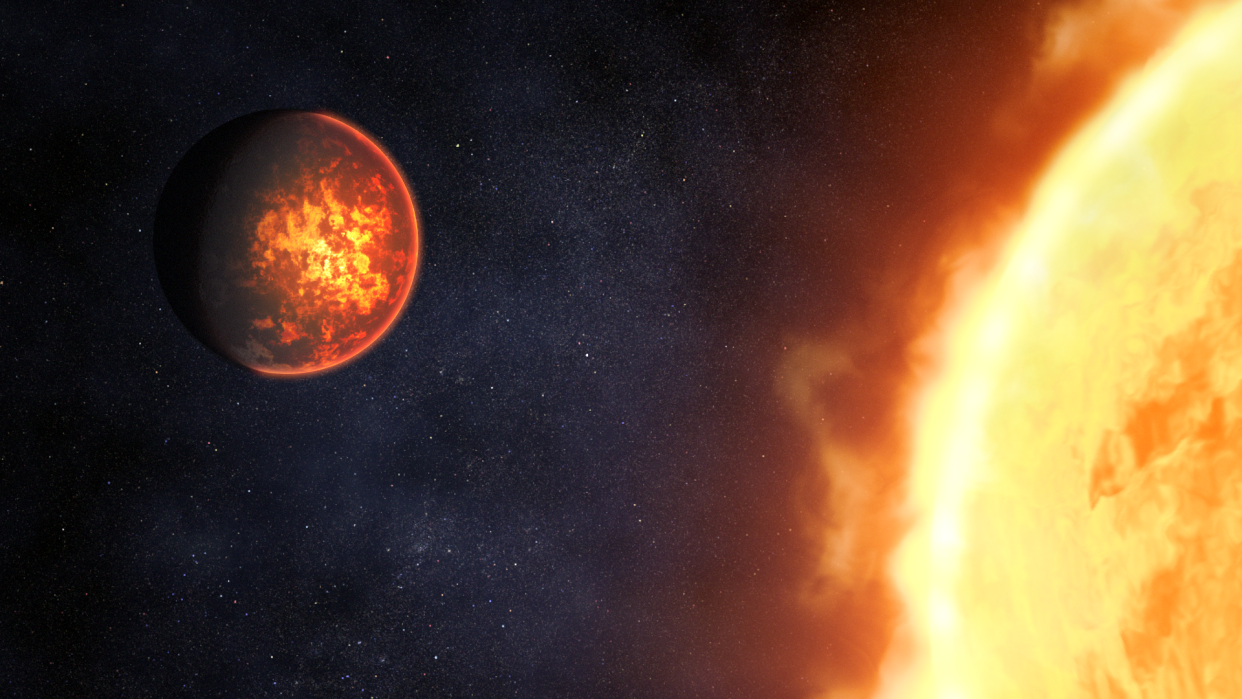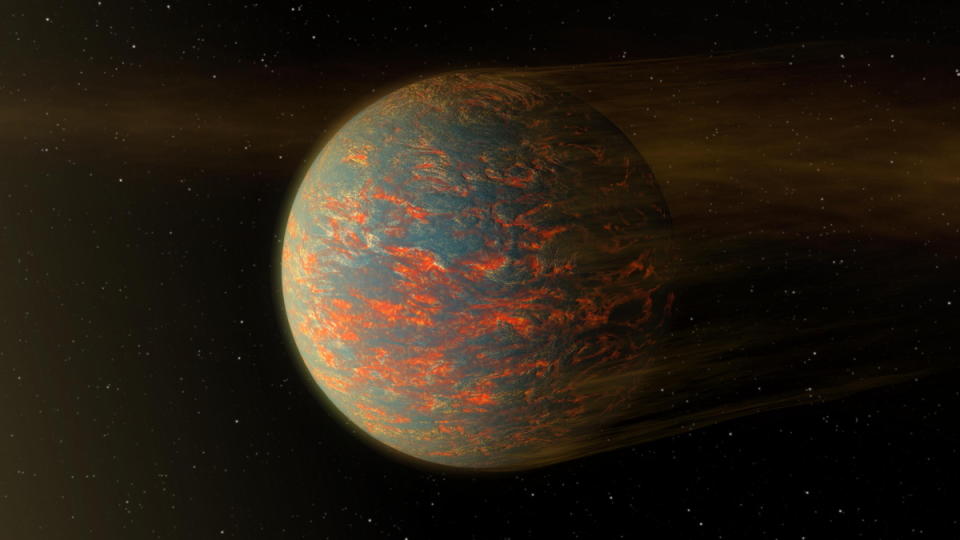This diamond exoplanet lost its atmosphere — then it grew another

Using the James Webb Space Telescope (JWST), astronomers have discovered that a scorching hot lava planet, believed to be composed of diamond, grew a second atmosphere — and that was after its star destroyed its first atmosphere.
The planet, known as 55 Cancri e, is located around 41 light-years from the solar system and has a width almost twice that of Earth and a mass around nine times greater than our planet. Among the bucket of extrasolar planets, or "exoplanets," scientists have cataloged over the years, this world is classified as a "super-Earth." That means it's more massive than Earth, but way lighter than planets like Neptune and Uranus. Yet, that's where comparisons to our world end for 55 Cancri e.
This exoplanet is so dense that astronomers have hypothesized it to be composed of mostly carbon that's been compressed to diamond. Also, the exoplanet exists a mere 1.4 miles (2.3 kilometers) from its sun-like star, 55 Cancri A. That's equal to 0.01544 times the distance between Earth and the sun. This proximity means 55 Cancri e orbits its host star once every approximately 17 Earth hours and has a roasting hot surface temperature of around 4,400 degrees Fahrenheit (about 2,400 degrees Celsius).
The radiation from its star has thus stripped 55 Cancri e of its original or primary atmosphere, just as is seen with other rocky planets that orbit their stars at such close proximities. However, the new research indicates a thick layer of gases surrounds the planet, implying it has "grown" a second atmosphere — and the scientists behind the discovery thinks they know how this happened.
Related: Citizen scientists find remarkable exoplanet, name it after Harry Potter character
"We measured the thermal emissions from this rocky planet, and the measurement indicates that the planet has a substantial atmosphere," Renyu Hu, a member of the team behind this discovery and a researcher at the California Institute of Technology (Caltech), told Space.com. "This atmosphere is probably supported by outgassing from the rocky interior of 55 Cancri e, and we think this is the first measurement of a secondary atmosphere on a rocky exoplanet. It is very exciting."
How 55 Cancri e defied its star
55 Cancri e was found in 2004 by the "wobble" it caused in its host star's motion, as seen from our perspective on Earth. This is called the radial velocity exoplanet discovery method for exoplanet discovery. Originally named Janssen, the world was the first super-Earth identified orbiting a distant main sequence star, or a star that is still converting hydrogen to helium at its core.
As the planet was investigated further, scientists also learned about its 0.7 Earth-day orbit and carbon composition. Then, in 2016, the Hubble space telescope determined that the atmosphere of 55 Cancri e contained hydrogen and helium during what was the first atmospheric investigation of an exoplanet.
Two possible scenarios exist to explain the atmosphere of 55 Cancri e.
First, the super-Earth could be a lava world atop which a thin, vaporized silicate atmosphere exists. It'd be made of the planet's volatiles and chemical compounds like carbon, nitrogen, hydrogen and sulfur that can be easily lost due to irradiation from its star. Or, alternatively, the planet could have a thick secondary atmosphere created over time through volcanism.
To investigate which of these scenarios was correct, Hu and colleagues examined JWST observations of the planet as it passed behind the star 55 Cancri A, an event called a secondary eclipse. Data from two secondary eclipses of 55 Cancri e ruled out the possibility of it being a virtually bare lava world lacking a substantial atmosphere.

There is no doubt that the planet is a lava-coated hellscape, and the team even thinks it is this molten nature that helped 55 Cancri e grow its secondary atmosphere.
"55 Cancri e is so close to the host star that it receives a lot of heat in the form of radiation. That heat keeps the temperature on the planet very high," Hu said. "At these temperatures, everything on the planet is molten. If it's rock, it's molten lava, which helps the outgassing process that supports a secondary atmosphere because of a molten surface."
He explained that gas dissolves in 55 Cancri's global lava ocean, constantly "bubbling out" to form the secondary atmosphere.
The researcher added that the original atmosphere of 55 Cancri e, which it would have had since its formation around its star, would have been composed of mostly hydrogen and helium. However, the composition of the secondary atmosphere that replaced the first remains uncertain.
"The composition of the secondary atmosphere depends on what the rock beneath it is made of," Hu said. "If the rock is very reducing [made of compounds that gain electrons and hydrogen], it can also create a hydrogen-helium atmosphere like the primary atmosphere. But if the rock is more like Earth's mantle, water, carbon monoxide and carbon dioxide would dominate the secondary atmosphere."
Hu added that, while the JWST observations of 55 Cancri e don't conclusively say what the planet's atmosphere is composed of, models used to explain the measurements favor a substantial amount of carbon dioxide and carbon monoxide.
Can 55 Cancri e truly create a secondary atmosphere?
55 Cancri e is by no means the only rocky planet seen orbiting so utterly close to its host star, though Hu points out it is among the hottest of its kind. So, does this mean that these other scorching hot terrestrial worlds could have grown secondary atmospheres, too? Well, the team isn't sure.
That's because there is something fairly unique about 55 Cancri e.
"At 1.8 times the size of Earth, it's a fairly large chunk of rock — and that helps to retain the volatiles against stellar irradiation," Hu explained. "We expect a very small rocky planet that is in a very close orbit around its star could lose its entire volatile budget from the whole planet, and then it becomes atmosphere-less."
That means it's not just the distance between a planet and its star that determines whether a planet will retain its atmosphere and "grow" another, but also the size of that world. Hu pointed out that, on both counts, 55 Cancri e seems to be "optimized" for replacing a lost primary atmosphere with a secondary atmosphere.
RELATED STORIES:
— NASA's TESS exoplanet hunter may have spotted its 1st rogue planet
— 400 Earth-size rogue planets could be wandering the Milky Way
— James Webb Space Telescope forecasts clouds of melted rock on this blisteringly hot exoplanet
Hu said the analysis of 55 Cancri e in this way would have been impossible without the observing power and infrared sensitivity of the JWST, which makes it ideal for characterizing the atmospheres of exoplanets.
"We're definitely thinking about the next steps for studying 55 Cancri e. We have some ideas about making the measurements of the planet's thermal emission, not just during secondary eclipses, but also as the planet revolves around the star," Hu said. "This will tell us about the size of the atmosphere and circulation within."
The team's research was published on Wednesday (May 8) in the journal Nature.

